Back in the early 20th century, food and cigarette companies would sometimes include collectible cards with their products. And that’s exactly what happened around 1910 when Wills’s Cigarettes included cards about the history of flying with their smokes.
The cards included illustrations of both successful and unsuccessful attempts by humanity at conquering the air. And some of the drawings are simply gorgeous.
The collectible card above featured Otto Lilienthal, a German aviation pioneer born in 1848, who made several successful attempts at flight with gliding machines. Lilienthal died in 1896 at the age of 48 when one of his gliders stalled out and he fell roughly 50 feet, breaking his neck.
The Aerial Steam Carriage of 1843
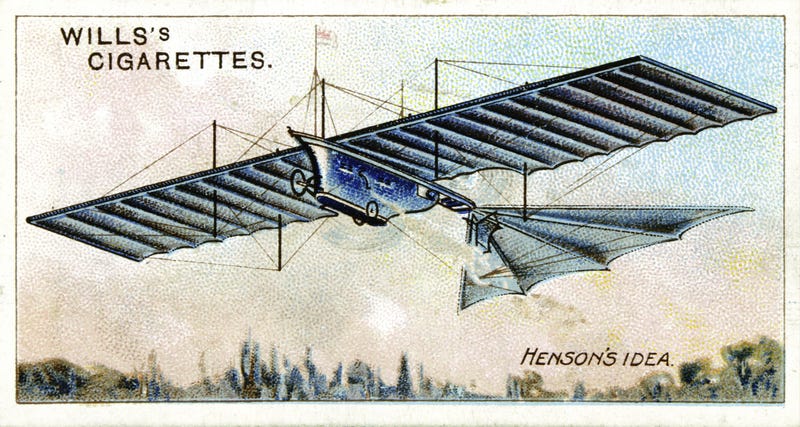
Another card included in the Wills’s Cigarettes collection featured William Samuel Henson, a British aviation pioneer born in 1805 who invented the Aerial Steam Carriage in 1843.
Henson planned to outfit a monoplane with a steam-powered engine able to produce 50 horsepower. Unfortunately for Henson, a small model he built was only able to fly incredibly short distances and a larger model failed to take flight. Thankfully nobody died in the Aerial Steam Carriage, a common occupational hazard of aviation’s experimenters.
Langley’s 1896 Aerodrome
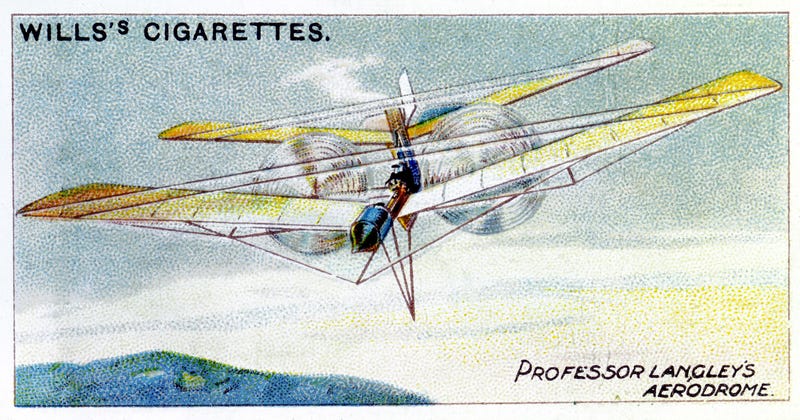
Another card from the Wills’s Cigarettes collection included a flying machine by Samuel Langley, an American inventor and aviation pioneer who served as the third secretary of the Smithsonian Institution starting in 1887.
Langley’s Aerodrome Number 5, which was featured in the card collection, was the inventor’s first genuine success with flight and is on display at the National Air and Space Museum.
The Aerodrome flew roughly 3/4 of a mile in 1896 and is credited as the first successful flight of an “unpiloted, engine-driven, heavier-than-air craft of substantial size,” according to the Smithsonian.
Nulli Secundus

Yet another card that was given out with packs of Wills’s Cigarettes featured the Nulli Secundus, the first steerable balloon used by the British military.
Produced in 1905, the balloon was designed by Col. John Capper and Samuel Cody and made a successful 3-hour trip over London in 1907. But the dirigible was destroyed by an intensely strong wind near London’s Crystal Palace, where it had been tethered.
Ader’s Flying Bird Eole
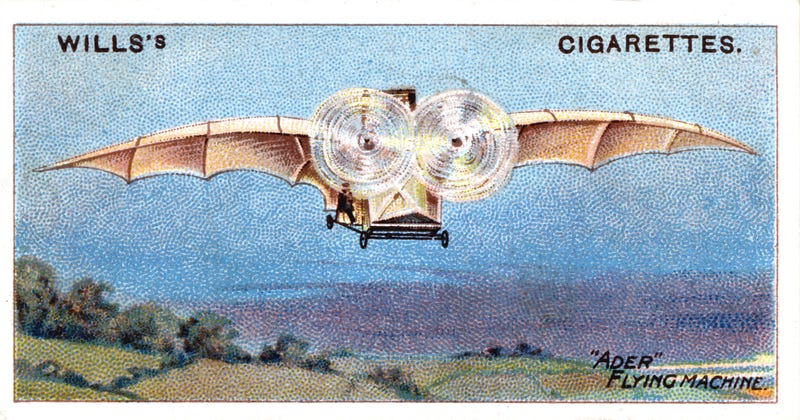
The card collection also featured this strange-looking illustration of the Ader Eole, a flying machine designed by French aviation pioneer Clément Ader. And while Ader claimed the Eole to be the first piloted plane to take off under its own power in 1890, achieving a flight of 50 meters using a 20 horsepower steam engine, there’s some debate about what the inventor actually accomplished without witnesses.
If nothing else, the design of Ader’s aircraft was so cumbersome that it sounded rather humorous. From Britannica:
In order to control the machine, the operator had to manipulate two foot pedals, six hand cranks, and the engine controls. The control system was clearly impractical.
Genius, if you ask us.
Besnier’s 1678 Flight
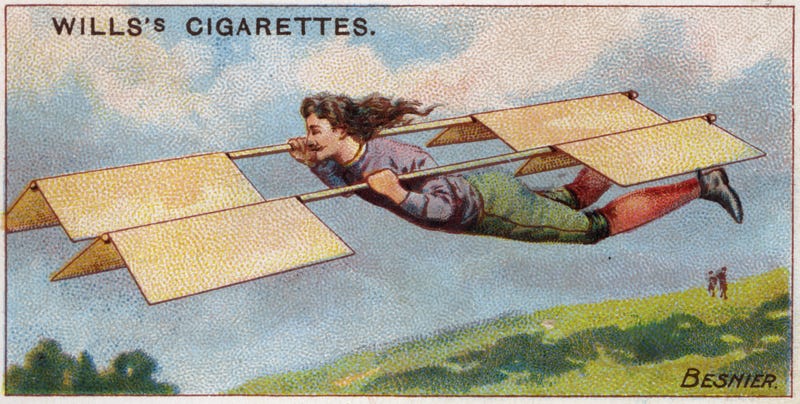
While most of the cards featured flying machines from the 19th century and early 20th, there was one card that featured a brave soul from the 17th century.
Besnier, a single-named French locksmith, was apparently obsessed with building different building flying machines, and the card above shows Besnier’s attempt at flight in 1678. A book from 1907 described the contraption this way:
He laid over each shoulder a rod, provided at each end with a collapsible right-angled aeroplanes. With every upward movement the planes flapped together, and, with every downward movement, formed a wide soaring surface.
But Besnier obviously couldn’t take off like a bird in this thing. It worked more like a glider, allowing him to, “fly from any lofty point in any desired direction.”
One aspect of this illustration that you don’t fully appreciate unless you look at other drawings from the time is that Besnier’s feet are attached to the back of each rod through ropes.
The Antoinette Monoplane
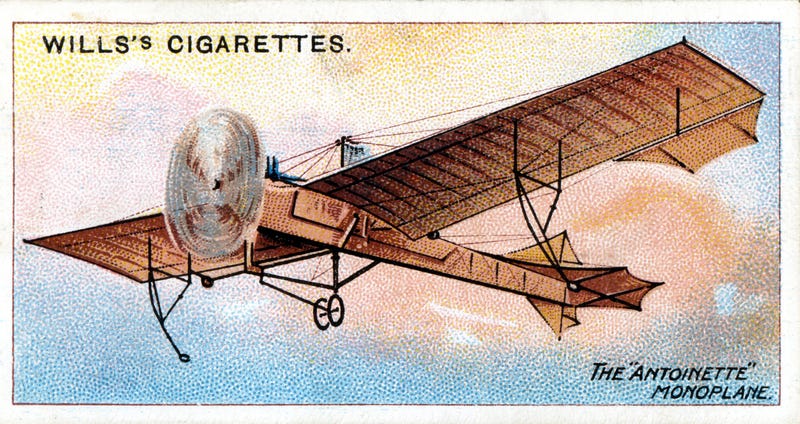
The Antoinette monoplane was featured in still another gorgeously designed card from Wills’s Cigarettes around 1910, not long after this aircraft made its debut.
The Antoinette was designed by French aviation pioneer Léon Levavasseur in 1908 and made several successful flights in the post-Wright Brothers era. Piloted by Hubert Latham, the Antoinette made two early attempts to cross the English Channel in 1909 but failed both times.
The Farman Biplane of 1909

This collectible card features the Farman biplane, another post-Wright Brothers aircraft that had considerable success. Designed by French aviator Henry Farman in 1909, the plane was so successful that other aircraft designers almost immediately started ripping him. Countless other aircraft started breaking endurance records in the first decade of the 20th century by using the “Farman type.”
Octave Chanute’s Biplane Glider
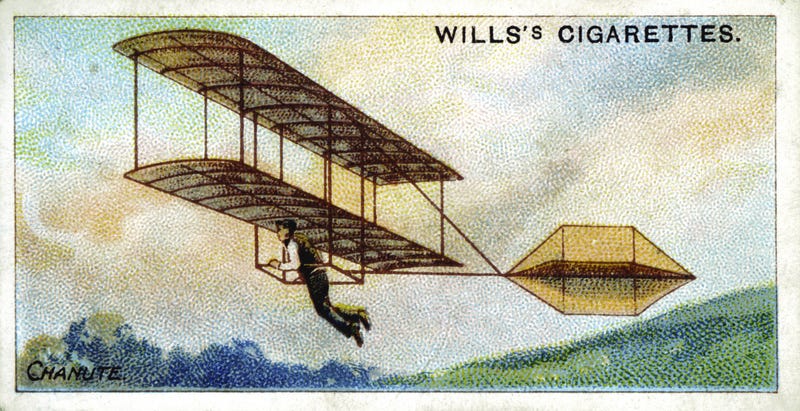
The cards also included a biplane glider designed by Octave Chanute, a French-American civil engineer who built the flying machine in 1896. Chanute was a tireless promoter of aviation and a big believer in sharing knowledge widely to help advance the goals of flight. But that same attitude brought him into conflict with the Wright Brothers who were extremely protective of their secrets.
First Woman to Hold a Pilot’s License

Elise Deroche, an actress better known by her stage name Raymonde De Laroche, was a French pilot widely considered to be the first “lady aviator” in the world when she made her maiden flight in 1909. And the Wills’s Cigarettes cards included an illustration dedicated just to her.
De Laroche was a press sensation in France and had an adventurous attitude that pushed her to become a test pilot for various experimental aircraft. Unfortunately, it was one of these experimental planes that she was co-piloting in 1919 when she crashed and died at the age of 36.
Wright Brothers
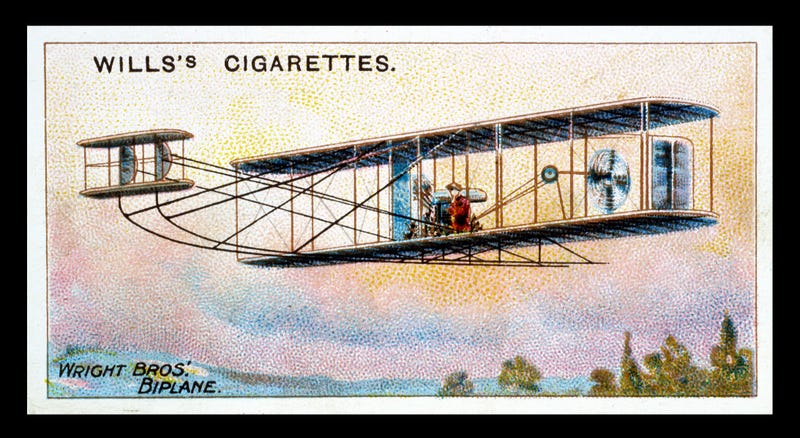
And, of course, the set of cards wouldn’t have been complete without the Wright Brothers’ own biplane. The Wright Brothers made their first powered flight at Kitty Hawk, North Carolina on December 17, 1903. And while it’s long been regarded as the first in the world—and certainly was considered the first by the American public who were seeing these cards around 1910—there’s still plenty of controversy surrounding the claim.
